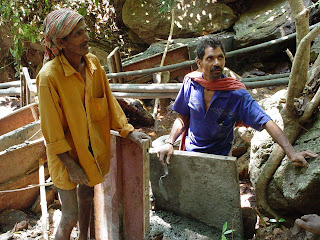Based on my experience with Gram Vikas' micro hydro, I would say that the penstock laying of a micro hydro system is the most challenging task of implementing a micro hydro system. Severe leaks in the Karlapat system delayed the commissioning by nearly a year! The second system also has leaks. Yesterday, we started the laying of the penstock of the 3rd system, Purna Guma. Bad planning on my part. I was hoping that the remaining tasks--turbine, transmission, etc.--could be done in parallel in the next week...but there are delays in getting the engineers at the site. And due to communication issues, I did not know of the delays until after the penstock supplier reached Kalahandi. ...Therefore, we have a half-done penstock that will cook in the sun until the rest of the tasks can be finished. ...The woes of working with multiple organizations and suppliers...not to mention my reactive emotions....are making my life far from boring.

Un finished installation of gate valve...

The supplier we are using did wonders in fixing the Karlapat leaks, and therefore we chose to use him for Purna Guma. He had come a week earlier to finalize Purna Guma plans with the Practical Action engineer. Plans were finalized but as he started the work, it was not according to plan. We had marked a penstock pathway with the engineer and the villagers. Some goat went away with the string marking, so the villagers guessed and made the 3'x1' path required by the supplier. Luckily their guess was correct, but the supplier wanted to add additional bends when they were not required, simply so that he could finish faster. Also, the villagers worked very hard to make the path, but in hindsight, I don't think the path was needed! As you can see in the photos, it would have helped to have 1' of land to lay the penstock on...

I am bit concerned about the gradual bends...I guess PVC allows this. We'll see when we test for leakage. The earlier marked path by the Practical Action engineer had no bends...

Since I'm complaining, I might as well explain how the supplier keeps going back and forth on whether we should put anchor blocks now or later. Since I questioned his decisions, he decided most of the remaining work on the line should not be finished until the Practical Action engineer arrives.

This supplier is really trustful...but the way he managed the villagers on this project was disappointing. He expected villagers to be out at 5am, as Jaysingh Babu is in this photo, but he himself wanted to leave the site early when villagers were still ready to work. (Every outsider who visits ends up wanting to leave as soon as they come...Maybe it's the remoteness; usually it is that they are a little sick and develop some phobia to stay. I need to find a solution for future visitors.) Villagers have their regular routines so that they can fit into the day all the various tasks they need to do just to survive. They have to take their animals out, do seasonal house repairs, prepare the fields, go to town, maintain their tools. Although these tasks sound simple, they all consume great time. When you require a village to break that routine, it's awful. Usually they end up over working their bodies. Low immune systems in malaria infested Kalahandi is bad news. ...And of course the supplier will be long gone when the villager has to deal with the dilemma of spending the money to visit a doctor 2 hrs away...or just let the malaria take care of itself...Lame. ...I have yet to meet any supplier in India that doesn't make my temperature go up. ....yes, I am breathing and calm...now :)

Because the supplier couldn't get the rated pipes we wanted (10kg) in time (although now we have an extra month thanks to the Practical Action engineers not being able to come and my needing to be in the US for a few weeks), we were forced to get more expensive pipes (12-14kg).

The rising Sun makes all woes disappear...

The guy with the head gear is one of the best mobilizers in the community. He's loud and happy :). I have much to learn from him.

...Not sure why we have to use fiberglass coating for the pipes....If these systems are meant to help the climate change struggle, we need to be examining what parts of the system also contribute to environmental woes, e.g. fiberglass coating, cutting trees for pipe supports, etc.

Fiberglass roll...This saved us in the last project where there were severe leaks due to the penstock being out of spec. ..but I wasn't expecting this to be used in the project. ...It's hard to change the dynamics once work starts...unless I really get my temper out in the open.
For now, I can only take these lessons as opportunities to do better in the next project. ...I shouldn't be so hard on the supplier. He's has been passionate about helping us with the previous leaks (now another older project has leaks), but it is difficult to work with his logic.
I am finding myself in extreme emotions these days. I can't seem to deal with lack of perfection in others...even though I completely lack perfection! I can't deal with the communication gaps, e.g. when people say one thing and do another. I let the negative emotions get the best of me. It is only when a villager at the site sees me that I change a little. ...Usually the older ones know when I am down. I become their daughter for a few moments....tremendous Love is transferred in those few seconds and I feel rejuvenated. Thank you, Universe. I am grateful.



















































